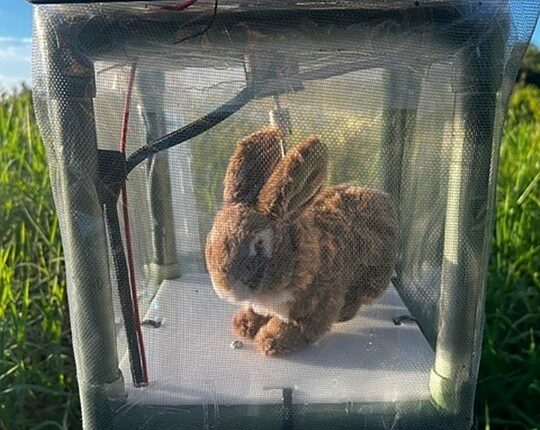Share this @internewscast.com

WEST PALM BEACH, Fla. (AP) — In an innovative initiative, South Florida employs robotic rabbits in the Everglades to attract Burmese pythons out of their concealment. These mechanical bunnies are designed to mimic the appearance, movement, and scent of the marsh rabbits that these invasive snakes traditionally prey upon.
The South Florida Water Management District spearheads this effort to reduce the python population, which has significantly threatened native wildlife by consuming vast numbers of them. According to officials in Everglades National Park, the snake infestation has led to a drastic reduction, wiping out 95% of small mammals and affecting many birds.
“Catching them isn’t that challenging; it’s spotting them that’s tough,” explained Mike Kirkland, the district’s chief invasive animal biologist. The problem lies in the pythons’ natural ability to blend seamlessly into their surroundings, making detection difficult.
This summer, in collaboration with University of Florida researchers, the district launched a trial involving 120 robotic rabbits. Kirkland noted that previous attempts to use live rabbits proved impractical due to high costs and time demands.
These robots are essentially modified toy rabbits equipped to give off heat, emit scent, and perform natural movements typical of a genuine rabbit. According to Kirkland, “They resemble real rabbits.” These devices are solar-powered, operational remotely, and are deployed in monitored pens with video surveillance that alerts when a python approaches.
“Then I can deploy one of our many contractors to go out and remove the python,” Kirkland said.
The total cost per robot rabbit is about $4,000, financed by the water district, he added.
Pythons, foreign to Florida, have become prevalent in the Everglades, either as escapees from captivity or through abandonment by owners once they’re too large as pets. The Florida Fish and Wildlife Conservation Commission reports that female pythons can lay 50 to 100 eggs in one breeding cycle, with an incubation period lasting 60 to 90 days.
It’s not easy to find definite estimates of the number of pythons in Florida. The U.S. Geological Survey recently reported a ballpark number of “tens of thousands,” while other official estimates run as high as 300,000 snakes. They have few natural enemies, although there are occasional confrontations with alligators, and other predators, such as bobcats and coyotes, will eat their eggs.
Since 2000, more than 23,000 of the snakes have been removed from the wild, the wildlife commission says. The robot rabbits are the latest attempt to tackle snakes that average between 10 and 16 feet (3 to 5 meters) in length when fully grown.
“Every invasive python that is removed makes a difference for Florida’s environment and its native wildlife,” said Ron Bergeron, a member of the water district governing board.
Pythons can be humanely killed year-round on private lands and on lands managed by the wildlife commission across the state.
Each year the commission holds a “Florida Python Challenge” that carries cash prizes for most pythons caught, the longest snake and so forth. This year, 934 people from 30 states took part in the effort in July, capturing 294 pythons with a top prize of $10,000 to a participant who bagged 60 of the reptiles.
It’s too early to determine how successful the robot rabbit project will be, but officials say initial results are a cause for optimism.
“This part of the project is in its infancy,” Kirkland said. “We are confident, though, that this will work once we are given enough time to work out some of these details.”
_____
Anderson reported from St. Petersburg, Florida.
















